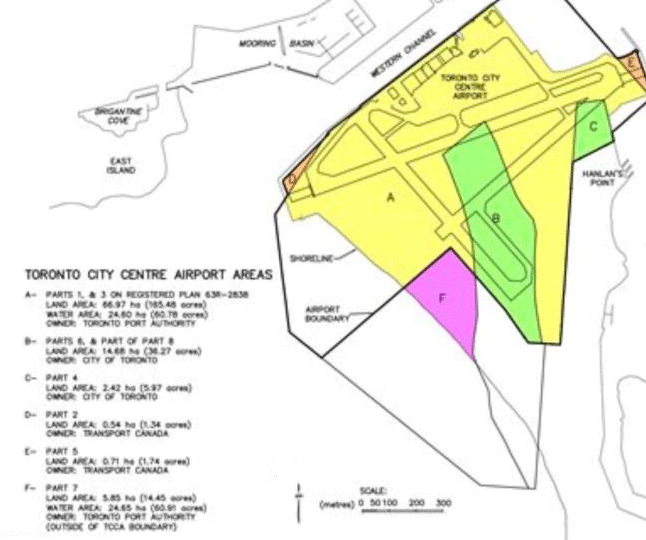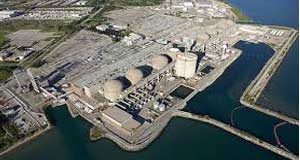We were struck by the preliminary cost estimate in the Nov. 22, 2017 report to the City of Toronto Executive Committee for the proposed Rail Deck Park project (8.3 hectares; 20 acres) is $1.665 billion (2017 constant dollars) or approximately $83 million per acre.
Although the report states that:
The rail corridor area is the last remaining site suitable for a major park (over 3 hectares) to support growth in the Downtown and serve as a city-wide asset, there is another nearby and much larger site suitable for a major park–the Island Airport Lands -a significant portion of which is currently leased by the city for nominal rent to the Toronto Port Authority (TPA, which has recently adopted the brand name “Ports Toronto”). That lease (called the Tripartite Agreement) has a term of 50 years, expiring June 30, 2033.
The entire Airport Lands comprise 87 hectares or 215 acres—the city’s portion (in green below) is significant: 16.7 hectares, or 41 acres.
The remainder of the lands (the yellow portion), save for a small portion(in orange, owned by the federal government), are owned outright by the TPA, having been given them free of charge by the federal government.
Without a renewal of the city’s lease, the airport cannot operate and alternative uses for all of those lands can be explored.
Those alternative uses present a massive opportunity for the city and its citizens to consider just what the most beneficial use of those lands should be.
We agree with this vision for our waterfront suggested by five of Toronto’s most influential community leaders:
It is our waterfront. From south Etobicoke to the Scarborough Bluffs and beyond, what is emerging all along the Toronto waterfront is one of the most remarkable transformations of its kind anywhere. The revitalization of these strategically located, obsolescent lands is providing new and improved places for the public to enjoy: parks and trails, a linked series of neighborhoods, places to live and work, and places of recreation, repose and natural beauty
The Island Airport’s not compatible with this vision.
With the success of the Union-Pearson Express, it can no longer be argued that the convenience of the Island Airport for Bay Street business people trumps that vision.
Already, the vast growth in population in downtown Toronto is placing pressure on the Toronto Island Park. It needs to be expanded.
From the city report:
Rail Deck Park is a once-in-a-generation opportunity for a major new park that supports future development in Downtown Toronto while also providing city-wide benefits.
Over the past decade, there has been a fundamental shift in the amount of growth experienced across the city. Development intensity has been particularly acute in the core of the city where population grew by roughly three times the rate of the preceding 10 years (40% compared to 13%).
The creation of new parks has not kept pace with this level of growth. Only two new parks provided in the Downtown area over the past 10 years have been greater than 3 hectares in size. The City is challenged in acquiring significant new parkland in a competitive real estate market. Typical land acquisition costs for free and unencumbered properties in the western area of Downtown Toronto range between $95 and $115 million per acre.
Ken Greenberg, Anne Golden, David Crombie, Jack Diamond and Paul Bedford, writing in the Toronto Star on Feb 9, 2014:
“Significant Downtown population growth is expected to continue for the foreseeable future, with current projections showing that 140,000 to 180,000 units could be added through 2041.
If this growth is to continue, there is a need for significant new infrastructure, including parkland, to ensure the quality of life, health, and sustainability of Downtown neighbourhoods. If this cannot be achieved, it may be necessary for the city to reconsider the pace and amount of future development in the Downtown.”
We think the same considerations that have led to the proposal for the Rail Deck Park also apply to the much larger, and vastly cheaper (for-the-city) Island Airport Lands.
As the National Post’s Chris Selley says: “And while I love the Island Airport to pieces, now that Downtown is linked by rail to Pearson, I’d have a hard time arguing against a sensible plan to turn it into a park and cede the tunnel to masses.”
— Brian Iler (http://www.communityair.org/)
 TheBulletin.ca Journal of Downtown Toronto
TheBulletin.ca Journal of Downtown Toronto
